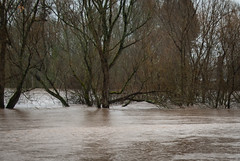
Model of possible debris dispersal (image courtesy of NOAA)
As the one-year anniversary of Japan’s devastating earthquake and tsunami nears, Oregon Sea Grant is teaming with state and local agencies, non-governmental groups and marine scientists to prepare for the possible arrival of earthquake debris on Oregon shores.
In a conference call this week, the group heard that state and county leaders, OSU Extension and the Hatfield Marine Science Center are receiving growing numbers of questions about the debris currently floating toward US coastlines, and began charting a communication strategy to help answer those questions.
OSU oceanographer Jack Barth, an expert in ocean currents, said the debris is still months away from making West Coast landfall, although occasional buoyant items might move more quickly. In October, a Russian ship discovered a small Japanese fishing boat in the waters north of Hawaii, and it was definitively tied to the tsunami, Barth said. “It was about where we thought it should be, given the currents.”
Many questions about the debris have to do with concerns that it might be radioactive, given the the incidents at Japan’s Dai-ichi nuclear plant that followed the earthquake. Kathryn Higley, professor and head of the Department of Nuclear Engineering and Radiation Health Physics at OSU, said the lag time between the tsunami and the nuclear incident, coupled with the vastness of the ocean, makes it unlikely that the debris will pose any radioactive risk. The material has been tossed by wind and sea for months now, Higley said, and most traces of radioactive elements will have washed into the sea. “While we may be able to detect trace amounts of radioactive material on this debris, it’s really unlikely that there will be any substantial radiation risk,” she said.
Meanwhile, Oregon Sea Grant’s marine Extension specialists on the coast have been working with multiple public and private partners, from state and local governments to conservation and fishing industry groups, to map out a communication strategy for the debris landing.
Jamie Doyle, Sea Grant Extension specialist in in Coos and Curry counties, said one concern is what happens to personal effects that survive the ocean crossing and wind up on Oregon shores, where they may be found by beachcombers.
“A lot of people lost their lives, and many people still have family members who are missing,” Doyle said. “We need to be sensitive to the possibility of finding something that may be of personal significance to someone in Japan.”
The Seattle office of the Consulate General of Japan has asked that those who find something that could be considered a personal keepsake or artifact report it to local authorities, or to the consulate in Seattle at 206-682-9107.
Patrick Corcoran, Sea Grant’s Astoria-based Coastal Hazards specialist, said Oregon’s focus thus far has been on research and “building the capacity to respond” to the arrival of the debris. Specific information will be forthcoming, he said.
Learn more:








